I. Glory Josephine*1 and K. Punnagai2
and K. Punnagai2
1Department of Pharmacology, Sree Balaji Medical College and Hospital, Bharath Institute of Higher Education and Research (BIHER), Chennai, 600044, India.
2Department of Pharmacology, Sri Ramachandra Medical College, Sri Ramachandra Institute of Higher Education and Research. Chennai, 600116, India.
Corresponding Author E-mail: dr.gloryj@gmail.com
DOI : https://dx.doi.org/10.13005/bpj/1715
Abstract
Costus igneus popularly known as ‘Insulin plant’ belongs to Costaceae family. The anti diabetic potential of the plant has been evaluated and widely used as Ayurvedic medicinal herb to treat diabetes mellitus and associated metabolic syndrome. Recently Non- alcoholic fatty liver disease (NAFLD) associated metabolic syndrome has been identified as an important risk factor for hepatocellular carcinoma (HCC). So agents with insulin sensitizing action could play dual role in the control of metabolic syndrome and cancer. This study is designed to evaluate the in vitro anticancer activity of the ethanolic extract of Costus igneus leaves against hepatocellular carcinoma( HepG2) cells. The viable cells were assessed by cytotoxicity activity (MTT assay) with the eight different concentration (1000 to7.8μg/ml) of the extracts. The percentage of viability was calculated. From the graph the concentration required for a 50% of viability (IC50) was calculated as 62.5μg/ml. However 74.57% and 22.65% of cell viability were produced by the concentration of 7.8μg/ml and 1000μg/ml respectively. The results showed the cytotoxic activity of ethanolic extract of Costus igneus leaves and proved the anticancer activity against liver cancer cells.
Keywords
Anticancer; Costus Igneus; HCC; MTT Assay; NAFLD
Download this article as:| Copy the following to cite this article: Josephine I. G, Punnagai K. In Vitro Cytotoxicity Activity of Ethanolic Leaf Extract of Costus Igneus Against Hepatocellular Carcinoma (HepG2) Cells. Biomed Pharmacol J 2019;12(2). |
| Copy the following to cite this URL: Josephine I. G, Punnagai K. In Vitro Cytotoxicity Activity of Ethanolic Leaf Extract of Costus Igneus Against Hepatocellular Carcinoma (HepG2) Cells. Biomed Pharmacol J 2019;12(2). Available from: https://bit.ly/2JPrqrY |
Introduction
Hepatocellular carcinoma is the second leading cause of cancer associated death worldwide with overall survival rate of 3-5%. Many global studies have analyzed the several guidelines for diagnostic criteria and therapeutic options of hepatocellular carcinoma (HCC).1 The primary surgical options are Resection and Liver transplantation which eventually depends upon the extent of the disease. But the integration with Loco-regional therapies (radiofrequency ablation (RFA), Percutaneous ethanol injection therapy (PEIT), Transarterial chemoembolization (TACE),Systemic therapy (Sorafenib) and Radiotherapy (External beam radiation therapy (EBRT)) increase the therapeutic options pertaining to the positive outcome. The leading etiologies of HCC are chronic hepatitis B, chronic hepatitis C, alcoholic cirrhosis, obesity and Non-alcoholic fatty liver disease (NAFLD).2 NAFLD is the hepatic manifestation of metabolic syndrome with insulin resistance which ranges from isolated hepatic steatosis to Non- alcoholic steatohepatitis (NASH) with or without cirrhosis. Numerous studies proved the rising incidence of NAFLD/NASH and increasing the risk of developing hepatocellular carcinoma. Studies proved that diabetes itself increase the risk of hepatocellular carcinoma in about twofold which subsequently leads to the development of both cirrhosis and carcinoma. Insulin resistance through insulin like growth factors lead to the accumulation of liver fat and might increase the cancer risk.3,4
The limitations of chemotherapeutic agents (Cost, toxicity, resistance) led to the extensive research work on plant products. Phytochemicals and their analogues play a significant role in cancer chemotherapy by either inhibiting cancer cell activating proteins, enzymes and signaling pathways or activating DNA repair mechanisms.5 Costus igneus commonly called as fiery costus, step ladder and spiral flag belongs to ‘costaceae’ family. It is native to South and Central America and widely used in India for cure of diabetes. It is perennial, upright, about two feet tall, spreading plant with the tallest stems and spirally arranged leaves. The beautiful orange flower appears on cone-like heads at the tips of branches. It is widely grown in gardens and leaves are used to treat diabetes by the tribal people in India.6 This plant has been used effectively in traditional medical system due to its anti diabetic potential. Diabetic patients are advised to take one leaf in the morning and one leaf in the night for one month.7,8 The aerial part is used for renal disorders in Mexican folk medicine. It is proved that the stem extracts of Costus igneus were effective in the prevention of renal stone formation. The stem extract and the isolated active compounds lupeol and stigmasterol significantly reduced the level of calcium and oxalate excretion in ethylene glycol induced urolithic rats.9
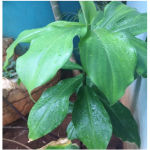 |
Figure
|
So many research works have been carried out and proved the anti diabetic potential of Costus igneus. Also studies proved the anti microbial, antifungal, diuretic, hypolipidemic, anticancerous and anti oxidant properties.7 The bioactive component diosgenin could be responsible for the antimicrobial and antifungal activities and served as a source for synthetic preparations. Studies proved that the leaf extract of Costus igneus possess antitumor activities in both in vivo animal models and in vitro cell lines against breast, skin, colon and lung cancer. Since there is a close co- relation between metabolic syndrome and hepatocellular carcinoma Costus igneus could play a major role in preventing and treating hepatocellular carcinoma. So this study is designed to prove the anticancer activity of ethanolic extract of Insulin plant ‘Costus igneus’ against hepatocellular carcinoma (HepG2) cell lines.
Materials and Methods
Plant Material
The leaves of Costus igneus were collected from in and around Madipakkam area, Chennai. The plant material was identified and authenticated by Prof P. Jeyaraman, Director, Plant Anatomy Research Centre, West Tambaram–Chennai (Reg no-PARC/2017/3441).
Preparation of Extract
Fresh leaves of Costus igneus were collected and washed under running tap water followed by distilled water. The leaves cut into pieces, air dried and powdered. 25 gram of powdered sample were taken and extracted with 300ml of ethanol in Soxhlet apparatus for 12 hours of time. The crude extract was filtered and the solvents were further condensed using rotary evaporator. The crude extract was stored at room temperature in airtight container for further analysis. A portion of the extract was used for evaluation.
Cell Line and Culture
HepG2 cell line was obtained from National Centre for Cell Sciences, Pune (NCCS). The cells were maintained in DMEM supplemented with 10% FBS, penicillin (100U/ml) and streptomycin (100μg/ml) in a humidified atmosphere of 50μg/ml CO2 at 37°C.
Phytochemical Analysis
Ethanolic extract of Costus igneus leaves contains carbohydrates, triterpenoids, alkaloids, proteins, tannins, saponins, flavonoids and steroids.
In Vitro Assay for Anti Cancer Activity: (MTT Assay) (Mosmann, 1983)10
Cells (1 x 105/well) were plated in 24-well plates and incubated in 37°C with 5% CO2 condition, After the cell reaches the confluence, the various concentrations of the samples were added and incubated for 24hrs.After incubation the sample was removed from the well and washed with phosphate-buffered saline (PH 7.4) or DMEM without serum.100μl/well (5mg/ml) of 0.5% 3-(4,5-dimethy-2-thiazolyl) -2,5-Diphenyl-tetrazolium bromide (MTT) was added and incubated for 4 hours. After incubation, 1ml of DMSO was added in all the walls. The Absorbance at 540nm was measured with UV-Spectrophotometer using DMSO as the blank. Measurements were performed and the concentration required for a 50% inhibition (IC50) was determined graphically. The % cell viability was calculated using the formula.
% Cell viability = A570 of treated cells / A570 of control cells x 100
Graphs are plotted using the % of cell viability at Y- axis and concentration of the sample in X-axis. Both the cell control and sample control are included in each assay to compare the full cell viability assessments.
Table 1: Anticancer activities of Insulin plant (Costus igneus) on HepG2 cell lines.
| S.No | Concentration (μg/ml) | Dilutions | Absorbance (O.D) | Cell viability (%) |
| 1 | 1000 | Neat | 0.147 | 22.65 |
| 2 | 500 | 1:1 | 0.198 | 30.50 |
| 3 | 250 | 1:2 | 0.245 | 37.75 |
| 4 | 125 | 1:4 | 0.293 | 45.14 |
| 5 | 62.5 | 1:8 | 0.339 | 52.23 |
| 6 | 31.2 | 1:16 | 0.386 | 59.47 |
| 7 | 15.6 | 1:32 | 0.433 | 66.71 |
| 8 | 7.8 | 1:64 | 0.484 | 74.57 |
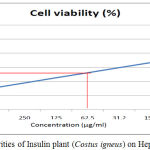 |
Figure 1: Anticancer activities of Insulin plant (Costus igneus) on HepG2 cell lines.
|
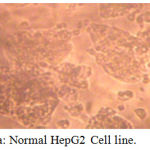 |
Figure 1a: Normal HepG2 Cell line.
|
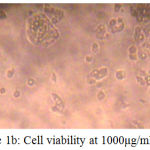 |
Figure 1b: Cell viability at 1000μg/ml.
|
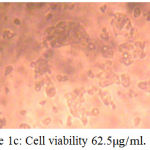 |
Figure 1c: Cell viability 62.5μg/ml.
|
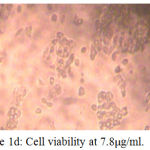 |
Figure 1d: Cell viability at 7.8μg/ml.
|
The viable cells were assessed by cytotoxicity activity (MTT assay) with the eight different concentration (7.8 to 1000μg/ml) of the extracts of Costus igneus. 74.57% and 22.65% of cell viability were produced by the concentration of 7.8μg/ml and 1000μg/ml respectively.
From the graph the concentration required for a 50% of viability (IC50) was calculated as 62.5μg/ml.
Discussion
Several case control studies showed the relationship between diabetes and hepatocellular carcinoma.11,12 Various possible mechanisms might explain the association. The important possibilities are Hyperinsulinemia, the interaction of insulin with liver cells, the reduction of IGF-1 and IGFBP-3, the loss of heterozygosity of p53, the metabolic effects of diabetes and increasing risk of Non –alcoholic steatohepatitis. So the inflammation, cellular proliferation, apoptosis inhibition and tumor suppressor gene mutations in advanced liver disease (Due to insulin resistance or hyperinsulinemia) might lead to HCC.13,14 Long term liver disease increases the prevalence of glucose tolerance by impairing the beta cell function. The correlation between the impairment of beta cell function and the mutations in hepatocyte nuclear factors is well established.15
Several studies proved the anti diabetic potential of Costus igneus. One study proved that the leaves of costus igneus reduced both fasting and postprandial blood sugar levels in dexamethasone-induced hyperglycemia in rats. The mechanism of the hypoglycemic action could be due to insulin release and sensitizing actions.16 Several in vivo, in vitro studies demonstrated the anti diabetic activity of Costus igneus and its effect on metabolic syndrome.17,18
Many phytomolecules exert their antitumor action by modulating cellular and signaling events involved in various stages of cancer. Polyphenols perform anticancer functions through induction of apoptosis, antioxidant mechanisms, cell growth factors modulation, angiogenesis inhibition and their selective action on rapidly dividing cells.19 Extensive research works carried out to prove the anticancer potential of different species of Costus. In vitro anticancer activities of Costus pictus on various cell lines elucidated the Histone deacetylase assay (HDAC) inhibitory activity on HepG2 cells. HDAC inhibitors inhibit the cell proliferation and apoptosis in tumour cells.20 The up regulation of apoptotic molecules P21, P27, P53,caspases, reactive oxygen species (ROS) and down regulation of anti apoptotic agents such as Akt, Bcl 2, NFkB, ,JAK, STAT3, MMPs, actin and vinmentin attributed to the anticancer mechanism of Costus specious.21 In vitro cytotoxicity assays on Ehrlich Ascites Carcinoma cell lines, Daltons Lymphoma Ascites cells and MCF 7 cell lines showed the anti proliferative potential of Costus igneus.17,22 So the above studies strongly suggested the promising role of Costus igneus in cancer chemotherapy.
Phytochemical analysis of Costus igneus showed the presence of carbohydrates, triterpenoids, alkaloids, proteins, tannins, saponins, flavonoids and steroids.23 It has been observed that flavonoids modulate the key elements involved in cell signal transduction pathways linked to apoptotic process and possess chemo preventive potential. Flavonoids -protein interactions with their antioxidant properties mediate the protective effect and suppress carcinogenic progression.24,25 Molecular docking analysis proved that diosgenin, a natural steroidal saponin isolated from Costus igneus rhizome is the potent blocker of the STAT3 activation pathway and possess anticancer activity in hepatocellular carcinoma.26 Diosgenin reverses the multidrug resistance in cancer cells and enhance the efficacy of standard chemotherapy.27 So the Insulin sensitizing, Cytotoxic and the anti oxidant activities of Costus igneus strongly suggested its anticancer potential in hepatocellular carcinoma.
Conclusion
The present study proved the anticancer activity of Costus igneus against hepatocellular carcinoma (HepG2) cells. Both the insulin sensitizing and anticancer activities clearly indicate its promising role in preventing and managing hepatocellular carcinoma. The antioxidant phytochemicals particularly flavonoids and diosgenin might be responsible for the cytotoxic activity which needs further evaluation and isolation of the active principle.
Acknowledgements
The authors thank the faculty- Department of Pharmacology, Sree Balaji Medical College, Chrompet, Chennai and Sree Ramachandra Medical College, Porur, Chennai for their support to conduct this study.
Conflict of Interest
There is no conflict of interest.
References
- Su Jong Yu. A concise review of updated guidelines regarding the management of hepatocellular carcinoma around the world: 2010-2016. Clinical and Molecular Hepatology, 22:7-17 (2016).
- Ju Dong Yang and Lewis R.Roberts. Hepatocellular carcinoma: a global view. Nat Rev Gastroenterol Hepatol, 7(8):448–458 (2010).
- CholankreilG, Patel R,Khurana S, SatapathySK.Hepatocellular carcinoma in non-alcoholic steatohepatitis; current knowledge and implications of management. World J Hepatol, 9(11):533-543 (2017).
- AmedeoLonardo et al. Non alcoholic fatty liver disease: A precursor of the metabolic syndrome. Digestive and liver disease, 47:181-190 (2015).
- Javed Iqbal et al. Plant-derived anticancer agent:Agreen anticancer approach. AsianPac J Trop Biomed, 7(12):1129–1150 (2017).
- Prakash,k.Hegde, Harini.A.Rao and Prasanna N. Rao. A Review on Insulin plant(CostusIgneus Nag). Rev, 8(15):67-72 (2014)
- ChoudhariU ,Sony ND, Rajnee and Maheshwari R. Awesome Indian plant(Costusigneus) : An Ecstasy of Natural remedy of Diabetes mellitus. Int J med pharm Res, 2(3):669-74 (2014).
- Elavarasi S and Saravanan K. Ethnobotanical study of plants used to treat tribal people of KolliHills. Namakkal district, Tamilnadu, Southern India.Int J Pharm Tech Res, 4(1):404-11 (2012).
- Manjula K, Rajendran K, Evera T and Kumaran S.Effect of CostusIgneus stem extract on calcium oxalate urolithiasis in albino rats. Urol Res, 40:499-510 (2012).
- MosmannT.Rapid calorimetric assay for cellular growth and survival.Application to proliferation and cytotoxic assays. J.Immunol.Methods, 65: 55-63(1983).
- PagonaLagiou et al. Role of Diabetes mellitus in the etiology of hepatocellular carcinoma. J of nat cancer Institute, 92:1096-99(2000).
- Turati et al. Metabolic syndrome and hepatocellular carcinoma risk. British Journal of Cancer, 108:222-228 (2013).
- Rubayat Rahman. Primary hepatocellular carcinoma and metabolic syndrome: An update. World J GastrointestOncol, 5(9): 186-194 (2013).
- Deepak N Amarapurkar, Nikhil D Patel and Praful M Kamani. Impact of diabetes 2016mellitus on outcome of HCC. Annals of hep, 7(2):148-51(2008).
- Allison Hodge. Is there any association between β- cell function and cancer risk. E Bio Med.22:24-25 (2017).
- Akhila J Shetty et al. Effect of Insulin plant (CostusIgneus) leaves on dexamethasone- induced hyperglycemia. Int J Ayurveda Res, 1(2):100-102 (2010).
- Choudhary Urmila et al. Antidiabetic potential of Insulin plant (CostusIgneus) leaf extracts in Streptozotocin induced diabetic rats.Int J of Medicine and Pharm Research, 3(2): 989–95 (2015).
- Dhanasekaran.S, Akshaya.M and Preethi.S. In vitro anti -proliferative potential of leaves of Costusigneus. IntJ inno in Eng and Tech.2014;4(4): 277-83.
- Singh et al. Lead phytochemicals for anticancer drug development. Front plant Sci,7:1-13 (2016).
- Neethu PV, Suthindhiran K and Jayasri MA. Methanolic extract of Costuspictus DON induces cytotoxicity in liver hepatocellular carcinoma cells mediated by histone deacetylase inhibition. Phcog Mag,13:533-8 (2017).
- El Far et al.Possible anticancer mechanisms of some Costusspeciosus active ingredients concerning drug discovery. Current drug discoverytechnologies.13:123-43 (2016).
- Sheik Abdulla Shahul Hameed et al. In vitro Antidiabetic, Anticancer and hypolipidemic activity of CostusIgneusE.Br. Int J Phar Tech, 9(1): 28955-69 (2017).
- Ramya Urs SK and Jyoti Bala Chauhan. Phytochemical screening, Antimicrobial activity and Anti oxidant activity of CostusIgneus.European J Molecular Bio and Biochemistry, 2(2):93-96(2015).
- Priya Batra and Anil K Sharma. Anti- cancer potential of flavonoids:recent trends and future perspective. Biotech, 3:439-59 (2013).
- Wasim et al.Flavone’s worth in the development of anticancer agents. Int J Drug Dev & Res, 9(2):26-32 (2017).
- Premila J, Logeshwari S and Shanmugapriya G. In silico molecular docking of STAT3 protein with bioactive compounds from Costusigneus against hepatocellular carcinoma. Int J Curr Res Aca Rev, 3:183-94 (2016).
- Gautamsethi et al.Pro-Apoptotic and anti-cancer properties of Diosgenin: A Comprehensive and Critical Review. Nutrients, 10(5):645 (2018).








